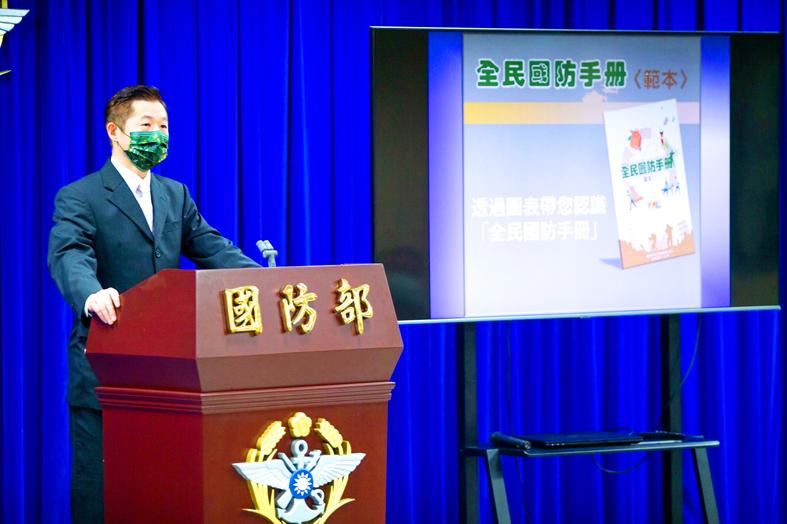The Ministry of National Defense has released a civil defense handbook aimed at informing Taiwanese how to seek refuge in major nationwide emergencies, including a military conflict, to be better prepared for various contingencies.
The 28-page Chinese-language handbook contains QR codes for users to scan to access directions for where to go and what to do in a major emergency, All-out Defense Mobilization Agency Director Liu Tai-yi (劉泰益) said at a news conference in Taipei yesterday.
The pamphlet outlines safety measures for civilians during an air raid, major fire, building collapse, major power outage, water shortage or shortage of essential goods, explains basic survival skills and offers an emergency hotline people can call, Liu said.

Photo courtesy of the Ministry of Defense via CNA
It also has a section on combat preparedness and wartime reserve force mobilization that provides a general guide on where reservists would have to report should a war break out, he said.
The ministry said that it has been working on the project since last year, and took into consideration information from similar handbooks issued by the Swedish and Japanese governments, as well as inputs from local governments, academics and experts.
The handbook is being issued amid concerns over China’s intentions toward Taiwan and the possibility that it could launch a cross-strait conflict.
It is available to download at https://www.mnd.gov.tw/Publish.aspx?title=國防消息&p= 79745&SelectStyle=公告專區.
In related news, the ministry early yesterday morning held an air defense drill to test the readiness of the military against an aerial attack.
The exercise, which ran from 5am to 7am, was conducted primarily to test the defensive capabilities and combat readiness of operational ground troops, the ministry said, without further elaboration.
Tthe aircraft used in the simulated air attack included F-16s, Indigenous Defense Fighters and AH-64E Apache attack helicopters, said a military official who asked not to be named.
The aircraft flew sorties over areas around Taipei without prior warning to verify the responsiveness of the nation’s air defense forces, the official said, and the drill was held early in the morning to avoid interfering with civilian aircraft.
It was an important test of the readiness of the military in the event of an aerial attack from China, the official added.

CALL FOR SUPPORT: President William Lai called on lawmakers across party lines to ensure the livelihood of Taiwanese and that national security is protected President William Lai (賴清德) yesterday called for bipartisan support for Taiwan’s investment in self-defense capabilities at the christening and launch of two coast guard vessels at CSBC Corp, Taiwan’s (台灣國際造船) shipyard in Kaohsiung. The Taipei (台北) is the fourth and final ship of the Chiayi-class offshore patrol vessels, and the Siraya (西拉雅) is the Coast Guard Administration’s (CGA) first-ever ocean patrol vessel, the government said. The Taipei is the fourth and final ship of the Chiayi-class offshore patrol vessels with a displacement of about 4,000 tonnes, Lai said. This ship class was ordered as a result of former president Tsai Ing-wen’s (蔡英文) 2018

UKRAINE, NVIDIA: The US leader said the subject of Russia’s war had come up ‘very strongly,’ while Jenson Huang was hoping that the conversation was good Chinese President Xi Jinping (習近平) and US President Donald Trump had differing takes following their meeting in Busan, South Korea, yesterday. Xi said that the two sides should complete follow-up work as soon as possible to deliver tangible results that would provide “peace of mind” to China, the US and the rest of the world, while Trump hailed the “great success” of the talks. The two discussed trade, including a deal to reduce tariffs slapped on China for its role in the fentanyl trade, as well as cooperation in ending the war in Ukraine, among other issues, but they did not mention

HOTEL HIRING: An official said that hoteliers could begin hiring migrant workers next year, but must adhere to a rule requiring a NT$2,000 salary hike for Taiwanese The government is to allow the hospitality industry to recruit mid-level migrant workers for housekeeping and three other lines of work after the Executive Yuan yesterday approved a proposal by the Ministry of Labor. A shortage of workers at hotels and accommodation facilities was discussed at a meeting of the legislature’s Transportation Committee. A 2023 survey conducted by the Tourism Administration found that Taiwan’s lodging industry was short of about 6,600 housekeeping and cleaning workers, the agency said in a report to the committee. The shortage of workers in the industry is being studied, the report said. Hotel and Lodging Division Deputy Director Cheng

‘SECRETS’: While saying China would not attack during his presidency, Donald Trump declined to say how Washington would respond if Beijing were to take military action US President Donald Trump said that China would not take military action against Taiwan while he is president, as the Chinese leaders “know the consequences.” Trump made the statement during an interview on CBS’ 60 Minutes program that aired on Sunday, a few days after his meeting with Chinese President Xi Jinping (習近平) in South Korea. “He [Xi] has openly said, and his people have openly said at meetings, ‘we would never do anything while President Trump is president,’ because they know the consequences,” Trump said in the interview. However, he repeatedly declined to say exactly how Washington would respond in